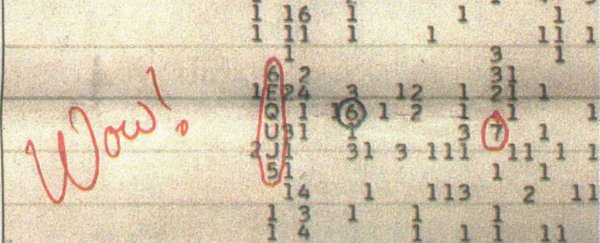On 15 August 1977, American astronomer Jerry Ehman detected something extraordinary - a cosmic radio signal that was so strong, some believed it to be an intercepted alien broadcast. Named after the "Wow!" Ehsan scribbled in red pen next to the signal on a computer print-out, its source has confounded scientists for decades.
But astronomer Antonio Paris says he's got the answer - and no, it's not aliens. The Wow! signal likely came from a pair of comets, called 266P/Christensen and P/2008 Y2 (Gibbs), as they sped past the now-defunct Big Ear radio telescope at Ohio State University, he says. "I came across the idea when I was in my car driving and wondered if a planetary body, moving fast enough, could be the source," Paris told Jesse Emspak at New Scientist.
The Universe is filled with a constant stream of background radio noise, which means only the strongest signals are likely to be picked up by our Earth-based and orbiting telescopes. And back in 1977, the Big Ear telescope recorded a signal so strong, Ehman knew as soon as he saw it that he'd stumbled on something extraordinary.
The telescope only got 72 seconds of the signal before losing it again, and two different values for its frequency have been proposed: 1,420.356 MHz and 1,420.4556 MHz. Regardless of which one is more accurate, that 1,420 MHz figure corresponds to a wavelength of 21 centimetres - also known as the hydrogen line.
"Searchers for extraterrestrial transmissions have long considered it an auspicious place to look, as it is one of the main frequencies at which atoms of hydrogen, the most common element in the Universe, absorb and emit energy," says Emspak.
This's important, said the Search for Extraterrestrial Intelligence (SETI) researchers who were working with Ehman at the time, because with such high amounts of hydrogen in the Universe, that 1420 frequency can easily penetrate the atmosphere to transmit a very strong signal - generated by extraterrestrial beings, perhaps. (Ehman didn't buy it.)
Ehman and his colleagues said the source of the Wow! signal was probably somewhere northwest of a globular cluster called Messier 55, near the Chi Sagittarii star group of the constellation Sagittarius - the largest constellation in the Southern Hemisphere.
Nothing like the Wow! signal has ever been recorded since. Astronomers have been able to rule out a number of possible sources, such as satellite activity and signals bouncing off the surface of Earth, but the 'alien broadcast' proposition has stuck around due to a lack of reasonable alternatives.
Until now, says astronomer Antonio Paris from at St Petersburg College in Florida. Based on the fact that nothing like the Wow! signal has been picked up from the same area since that 72-second moment in time, he says it was likely created by the vast clouds of hydrogen gas released by the comet pair as they shot past the Big Ear telescope's field of view.
Having traced the path of the comets all the way back to that day in 1977, he says it's possible to place them in the vicinity of the Messier 55 globular cluster at that time, and the fact that no one knew they existed when the Wow! signal was recorded explains why no one pinned them as a possible source earlier.
"To test his idea, Paris proposes looking at the same region of space when the comets are back," says Emspak. "Comet 266P/Christensen will transit the region first, on 25 January 2017, then P/2008 Y2 (Gibbs), on 7 January 2018. An analysis of the hydrogen signal of the comets should reveal if he is correct."
His research has been approved for publication in the Journal of the Washington Academy of Sciences.
So we basically have to wait a couple of years for these comets to give us the evidence we need to prove or disprove Emspak's idea. But even now, the explanation has its critics. "If comets were radio-bright at 21 centimetres, I would be puzzled as to why they aren't observed more often at those wavelengths," astronomer James Bauer from the Jet Propulsion Laboratory told New Scientist.
Guess the alien enthusiasts can hold onto this one just a little longer then.
